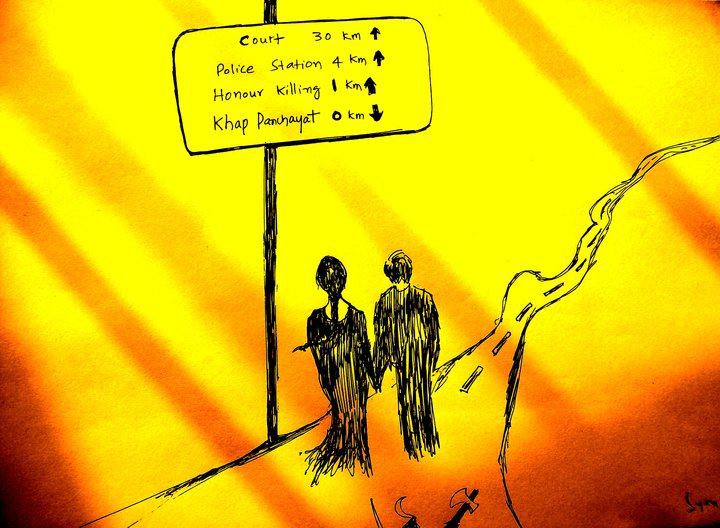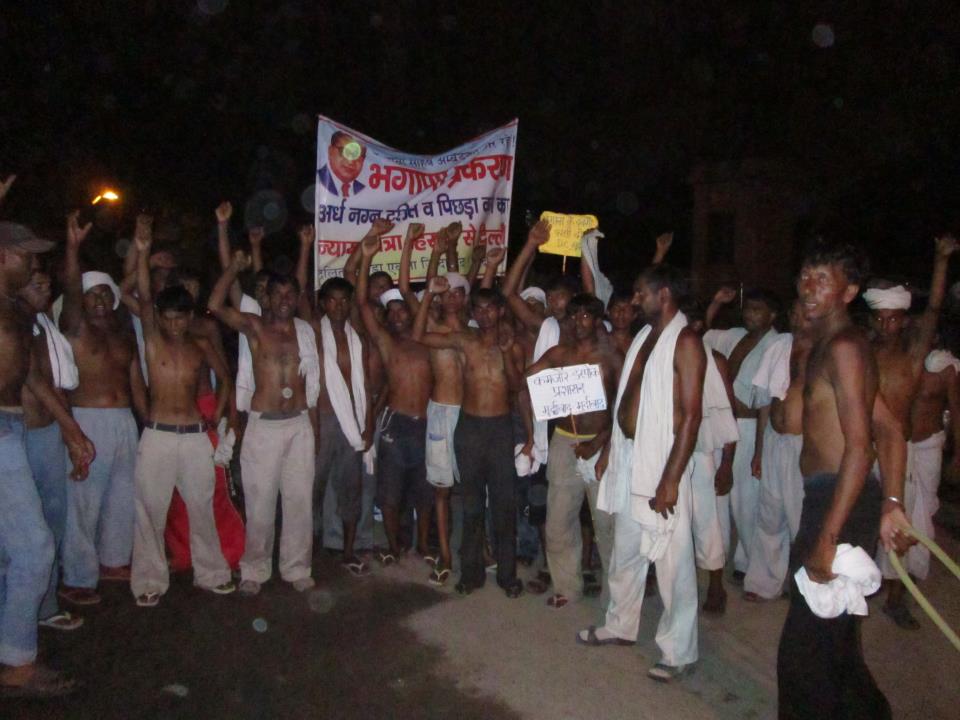Harish S. Wankhede
In any normal political chat, the general upper caste tendency is to accuse the Dalits of politicizing the lower caste identity against the nationalist concerns of citizenship and secularism. This is an easy option to hide the actual domination of brahmanical culture over the public institutions. The social psyche of ‘governamentality’ in India is not secular-rational in a Weberian sense but channelized with the rooted sense of traditional-cultural religious values. The cases of brutal caste violence in Bathani Tola (1996), Lakshmanpur Bathe (1997), Nagari (1998) and Miyapur (2000) were the demonstrative examples that the rural society in Bihar is still gripped in the violent and inhumane control of the feudal-upper caste assertions. The only faith for justice relied on the judiciary. However, the recent judgments by the honorable Patna High Court on the above mentioned cases have shocked the aspirants of justice. All the accused were set free by the Court, as if no one had killed the Dalits. The judgments overtly reflect that the judges have acted with a biased upper caste self-consciousness and protected the criminals, belying the hope that the judiciary will act in a rational fair manner to uphold the cherished modern value of social justice.

India: the Modern Rational Nation
The newly independent India had begun its operation by noticing three forms of human sufferings: socio-economic inequalities, religio-cultural differences and the absence of a moral thread that can bind the diverse subjectivities towards a normative consensus. In a desperate crave for justice, peace and equality, the hopeful people posed their faith in the rational-secular institutions of the state. It was a revolutionary hope, as in the Constituent Assembly, the nationalist leaders showed readiness to invite a grand idea that can replace our particular conscious of communal ‘self’ with a new collectivist idea of ‘citizenship’. In the language of psychology, it is thought that the ‘neurosis’ created by our regimented internal differences can be cured by adopting new modern ‘schemata’. The new state is heralded as a replacement for all the singular powers of various guilds, tribes and caste communities that used to rule the pre-modern societies. The Constitution is the epitome of justice and an assurance that the law will not succumb or be biased towards any individual, caste or community. The quasi-distribution of power between Parliament, Executive and Judiciary is visualized so that the people are now secured under the new garrisons. However, the post-colonial experiences with our democratic institutions are a demurrer against such celebrated utopian ideals.
No forms of grand organization setup can bring justice to a society that is devoid of collective consciousness. For building a robust collective national fraternity, it primarily requires that statesmen must be divorced from one’s social and cultural instincts while delivering justice. As of now, our dominant political leadership and bureaucratic junta is condemned because it is experienced that they are motivated towards their duties not by secular-rational instincts but on the basis of their caste-communal orientations. The judiciary, by and large was not reprimanded by the same logic till date. However, the above mentioned High Court judgments have substantiated the claims that even the ‘neutral-rational’ judiciary has been contaminated by caste and communal prejudices. This is the actuality of our ruling elites and therefore, the hope that the servile, poor class/castes will be protected under the modern state and law, now appears an overrated hope.
Communal Self in a Secular Realm
In social theory we learn that the fabric of a person’s identity is woven together in his/her socio-cultural discourse. His/her judgments about rational concepts are influenced by the environment helpful in his/her upbringing (Burr 1995: 51). Psychoanalysts argued that politics and social bonding between the individual and groups are nurtured by the dominant knowledge practiced in society. Our emotional responses are linked to the process of judgment and allow us to interpret actions in positive or negative light. Culture works as an enforcing ideology through socio-religious norms and beliefs that gets embedded in the individual’s consciousness (Powell 2010: 103). However, cultural environment is not the deterministic force that compels individuals to act in a certain way, on the other hand the new rational-secular culture forces him to think in yet another direction by evoking greater moral components and objectives. We reposed our hope in the judicial system mainly because we believe that the judges will not get arrested by their conventional ‘super ego’ but uphold the validity of public consciousness to deliver fair justice. In the current debates over the Court’s verdict it has not been argued that the caste culture of the judges does determine their perceptions over judgments in a subtle way. However in the judgments offered by the Patna High Court over caste violence, it appears that the personal fancies and caste emotions had overtly influenced the decisions. It represents their regressive caste prejudices and contempt against the Dalit subjects while delivering justice.
The nation builders adopted a combination of modernization, secularism and social justice as the essential values to correct the pressing problems of past history. For the Dalits, the new modern system differentiated the early terrible conditions of poverty, violence and exploitation and promised a new land of human goodness and creativity. Ambedkar was hopeful that the inner caste core of the individual that constitutes one’s public identity will be transformed by the sustained impact of modernization and will invent a new secular self. This was a heightened belief that the sentimental attachment with the ascriptive socio-cultural identity is malleable and everyone will march towards self-improving their personal character to achieve the objectives of citizenship, including the Dalits. The social elites were the most vocal proponents of such nationalist secular feeling. However, the past experiences suggest that the conventional ruling elites only changed the nomenclature of their domination and retained the core psyche of brahmanical caste culture intact.
The conventional ruling elites in post-colonial India were depressed and felt suffocated under the hegemonic political conditions presented by the secularism-social justice discourse and remained eternally motivated to escape from such trauma. The idea of secular modernization was challenged by aggressively evoking communal macho religious identity under the garb of communal Hindu nationalism. Its worst local avatar was the birth of upper caste men led private armies (Senas) in early 1990s to decimate the rise of militant Dalit assertion in Bihar. Both the assertions in an overt way validate the rejuvenation of the brahmanical social ideology against the basic tenets of the modern constitution.
The Contemporary Challenge
The contemporary predicament in India is this tussle between the embedded subconscious egoist culture (based on brahmanic upper caste agenda) and externally fabricated conscious modern rational self (secularism-social justice agenda). Conflict simultaneously exists at the level of individual, society and the state over identifying the actual path to follow. A psychoanalytical report on the recent court verdicts will demonstrate that the judges have not acted in a fair rational manner but were governed and dominated by their ‘super-ego’ embedded in their emotive cultural bonding, nurtured in a peculiar caste condition. This conflict, if aggravated, has a capacity to permanently disturb the dominant modernist agency of India’s constitutional ethics.
The traumatic events of caste atrocities in India suggest empirically that it is not only the individual who can get divorced from the rational-secular modern culture but a whole community can develop such neuroses. The complacency of civil society in reacting against the cases of caste discrimination, social violence and rapes and murders of Dalit-Tribal women indicates that such allegation about its ‘casteist nature’ is not far from the truth. The several cases of atrocities cannot be called just aberrations occurring due to failure of modernity in replacing the remnants of feudal-caste society but these are sanctified and protected under the tacit support of the civil society by using the means of coercive force, public indifference or by a lethargic interpretation in the media.
The Dalit public sphere is completely damaged and traumatized by perpetual experiencing of social violence and atrocities. The hope of developing a shared cultural value based on fraternal considerations has almost collapsed, rather an antagonistic phenomenon has been generated that will push the Dalits to consider the current context as identical to the exploitative pre-modern conditions. The apathy and injustice by the state can isolate the whole community from modern virtues. Their newly built social aspirations, cultural spaces and political confidence have been consistently pushed back by the repressive acts of the social brahmanical repressive regime. The Dalits have remained the most vocal supporters of the modernist rational public sphere as they realize that only in such a legitimate democratic space their voice can be heard. However such uninterrupted cases of violence and injustice have the capacity to shake their confidence in the rationale of modern institutions, including the judiciary.
~
References
Burr, Vivien (1995), An Introduction to Social Constructionism, Routledge, London.
Powell, Shelliann (2010), “Psychoanalysis and the Study of Political Science” in Howard J. Wiarda (ed.) Grand Theories and Ideologies in the Social Science, Palgrave Macmillan, New York.
~~~
Harish S. Wankhede is assistant professor of political science at Delhi University.
Cartoon by Unnamati Syama Sundar.









